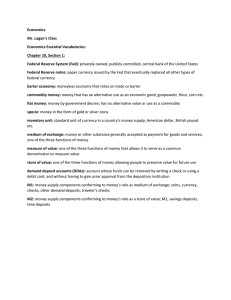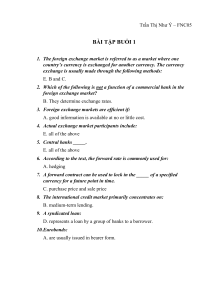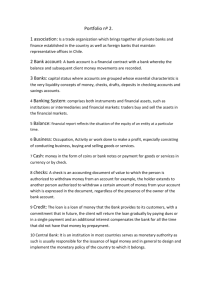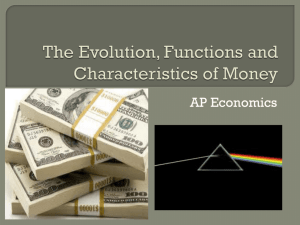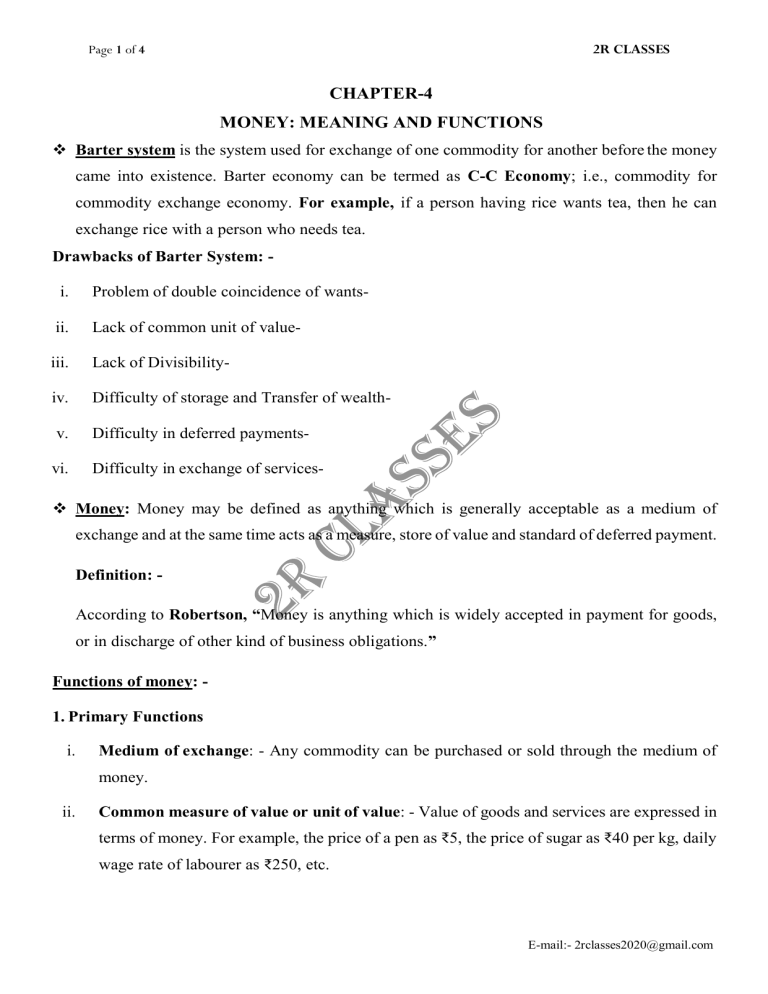
2R CLASSES Page 1 of 4 CHAPTER-4 MONEY: MEANING AND FUNCTIONS Barter system is the system used for exchange of one commodity for another before the money came into existence. Barter economy can be termed as C-C Economy; i.e., commodity for commodity exchange economy. For example, if a person having rice wants tea, then he can exchange rice with a person who needs tea. Drawbacks of Barter System: i. Problem of double coincidence of wants- ii. Lack of common unit of value- iii. Lack of Divisibility- iv. Difficulty of storage and Transfer of wealth- v. Difficulty in deferred payments- vi. Difficulty in exchange of services- Money: Money may be defined as anything which is generally acceptable as a medium of exchange and at the same time acts as a measure, store of value and standard of deferred payment. Definition: According to Robertson, “Money is anything which is widely accepted in payment for goods, or in discharge of other kind of business obligations.” Functions of money: 1. Primary Functions i. Medium of exchange: - Any commodity can be purchased or sold through the medium of money. ii. Common measure of value or unit of value: - Value of goods and services are expressed in terms of money. For example, the price of a pen as ₹5, the price of sugar as ₹40 per kg, daily wage rate of labourer as ₹250, etc. E-mail:- 2rclasses2020@gmail.com 2R CLASSES Page 2 of 4 2. Secondary Functions i. Standard of deferred payment: - In modern economic system, loans are generally given & taken and the repayment is generally postponed for a future date. ii. Store of value: - A store of value implies the shifting of purchasing power from the present to the future. It enables people to save a part of their current income and store it for future use. iii. Transfer of value: - Money helps us to transfer values from one person to another person and from one place to another. Indian Monetary System: Monetary standard refers to the type of the standard money used in a country. The present monetary system in India is managed and controlled by the Reserve Bank of India. In India, the rupee has been regarded as the standard money. It means all payments and transactions are made in terms of rupees and as such the currency is expressed in terms of rupees (₹). The currency in India is in two forms: coins and paper currency. The rupee coin is token coin made of nickel and its face value is higher than its metallic value. All the coins and one rupee notes are melted/printed by the Finance Ministry of the government of India. These cons are limited legal tender because they can be paid only up to a limited amount. The printing of paper money (currency notes) is the monopoly of the Reserve Bank of India (RBI). RBI prints and issue notes from two rupee notes to the two thousand rupee notes. The currency notes are unlimited legal tender money as they can be paid to any extent in effecting transactions. The present system is known as the Minimum reserve system of note issue, because the RBI maintains reserves against currency notes, consisting of a minimum of gold and foreign securities to the extent of ₹200 crores (₹115 crores of gold & ₹85 crores of foreign securities). Types of Money: 1. Fiat money: Money issued by order (fiat) of government and people are legally bound to accept it. For example, notes or currency. 2. Fiduciary money: Money which is accepted as a medium of exchange because of trust between payer and payee. A person is not legally bound to accept it. For example, cheque or E-mail:- 2rclasses2020@gmail.com 2R CLASSES Page 3 of 4 bills of exchange. 3. Full bodied money: Money refers to that money whose intrinsic value (value of the metal) is equal to the face value of the engraved on the currency. 4. Credit money: Money refers to the money whose money value is more than commodity value, like ₹2000 or ₹500 notes. Supply of Money: Total stock of money (currency notes, coins and demand deposit of banks) in circulation are held by the public at a given point of time. Supply of money does not include cash balance held by central and state govt. and stock of money held by banking system of country as they are not in actual circulation of the country. Measures of Money Supply : 1. M1 = C + DD + OD C = Currency and coins with the public DD = Demand deposits of the public with the commercial and co-operative banks OD = Other deposits with the RBI 2. M2 = M1+ Post office savings deposits with Post Office Saving Banks 3. M3 = M1+ Time deposits of commercial banks 4. M4= M3+ Total deposits with the post office saving organization E-mail:- 2rclasses2020@gmail.com 2R CLASSES Page 4 of 4 Factors Affecting Money Supply: 1. Monetary Policy of the central Bank: - If the Central bank follows a dearer money policy (increase in bank rate & Cash Reserve Ratio and Purchase of securities in the open market, etc.) the money supply will be reduced, On the other hand, if the central bank adopts a cheap money policy, the money supply increases. 2. Commercial Banks’ capacity and policy of Credit Creation: - The larger the cash balance, the more will be the volume of deposit expansion and vice versa. Lower is the Cash Reserve Ratio, greater is the ability of the banks to create credit. 3. Government’s fiscal policy: - When government follows a deficit budget policy (excess of public expenditure over public revenue), the money supply increases. On the other hand when government follows a surplus budget policy (excess of public revenue over public expenditure) the money supply decreases. 4. Community’s choice: - If the public desires to hold more cash than the credit creation is lesser, and vice versa. Banking habit of the public also affects money supply in the economy. COMPLETED E-mail:- 2rclasses2020@gmail.com
